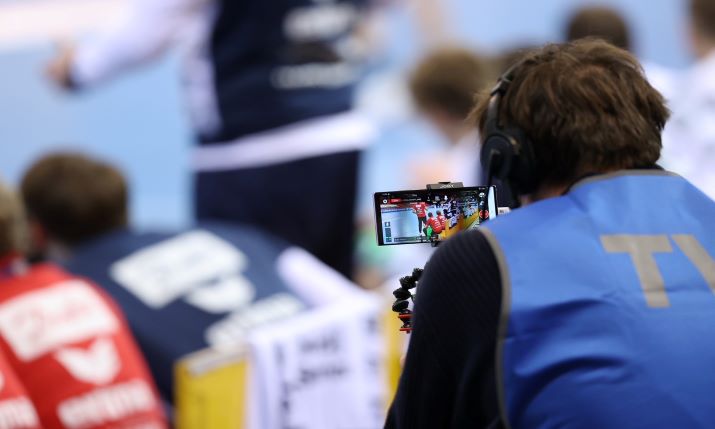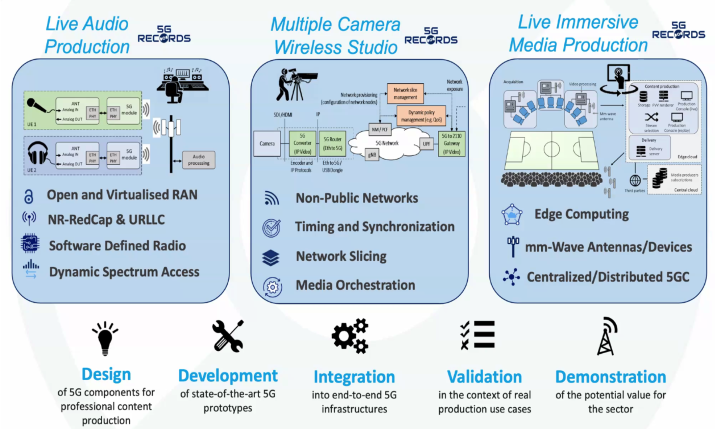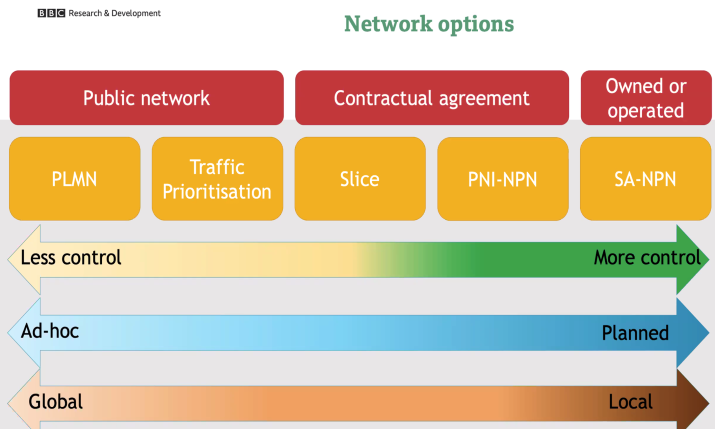Trials and challenges: Unlocking the potential of 5G for sports broadcast production
 By Ian Wagdin, BBC Research and Development senior technology transfer manager
By Ian Wagdin, BBC Research and Development senior technology transfer manager
You cannot have failed to hear about the latest generation of mobile technologies labelled 5G. It has the potential to have a significant impact on all areas of our lives with promises of high speed, high quality, always-on connectivity.
5G also has the potential to change how we create content. Currently we rely on a number of technologies to get pictures and sound from cameras and microphones into our broadcast centres for contribution onto our programmes. These include fixed link fibre connections, satellites and even motorbike couriers delivering hard drives.
Onwards from bonded cellular
For several years we have also been using a technology known as ‘bonded cellular’ which takes a number of 3G or 4G connections and groups them together to provide enough bandwidth to send a live video feed over mobile networks.
These bonded cellular units have revolutionised workflows by allowing us to go live from anywhere with suitable coverage using a simple backpack or camera mounted device to encode and relay video without the need for large vehicles and lots of cables.
As with any technologies there is room for improvement. These units require multiple connections which in turn require multiple SIM cards and of course, if you are outside the coverage area of one provider, you need SIM cards for an alternative network. Additionally, they are primarily designed for news contribution and use heavily compressed video, and there is no separate provision for audio workflows.
There is also no differentiation between the networks that these devices connect to and public networks, so at large events the connections become unreliable as you fight for connectivity with the crowds. They are great for contribution, but with no local break out, high latency, and no real quality of service, they are not yet suitable for use in a demanding production environment.
 Migration to IP
Migration to IP
We are also in a migration from digital workflows from those based on internet protocol (IP). There are several IP based tools in everyday use in production such as DANTE and AES-67 for audio and ST2110 and NDI for video, but these are optimised for wired workflows and often wireless technologies are interfaced via gateway devices and we don’t get the full benefits of IP by reaching the end device.
We also have to be mindful that as mobile technologies develop and increasingly dominate how we work, they need radio spectrum. In many areas, we have already seen the 700Mhz band cleared to make way for new services. In the future we may see other spectrum being assigned for further uses, and as we move away from terrestrial broadcasting, and we may not have access to the technology or spectrum that supports our current wireless workflows. In production we use radio spectrum not only for contribution but also for radio cameras, radio microphones, in-ear monitoring, talkback, and reverse video feeds.
Changing times
If we combine these two changes, the move to IP and the threat to existing spectrum we need to explore emerging technologies that can support production requirements. This will result in one of two outcomes: either we can migrate to wireless IP solutions; or we need to make the case to maintain existing spectrum, but as with all new ways of working, this will be a long term process with a gradual migration over several years.
5G (and subsequent generations) is one suite of technologies that can support wireless IP, of course there are others such as Wi-Fi and other related protocols such as DECT and Bluetooth that will play their part.
As with any technology that improves how we may make content, there is significant interest in how it may be deployed, not just from the production community but also from the mobile industry, who want to understand and support the challenges of a live production environment.
The mobile communications world is a rapidly changing one which can be described as more evolutionary than revolutionary. It is likely that solutions will appear to replace current cellular bonding technologies deployed on 3G and 4G networks, even if we did nothing.
Helping the mobile telecoms industry understand what we do and how we do it means showing that production of a broadcast is far more than a one-way video call.
We also need to understand the 5G technology stack; that it is not a single technology but a suite of different services, some hardware and some software based. This takes time, and we cannot expect an overnight change.
 5G working group
5G working group
In May 2018 a group of EBU Members, partners, suppliers, and other interested parties got together to form a working group on 5G in Content Production (5GCP). At the same time the standards body that oversees mobile technologies (3GPP) launched a study as to the requirements of audio and video production alongside several other studies into other industry use cases. The aim was to identify how 5G may be updated in future releases to best meet the requirements of content producers.
Other groups such as 5G Media Action Group (5G MAG) have now emerged to support dialogue between the two industries, not just in standards, but also in tackling the commercial and regulatory aspects needed to support production.
In addition to this there are several research projects, test and trails that are actively exploring what we need and how we may integrate and use 5G in production. An EU funded project, 5G Records, is looking specifically at extremely low latency audio workflows, wireless cameras, including support for media orchestration and control, as well as the use of 5G to support multi-viewpoint video. In other tests and trail there is work coordinated by IBC that is looking at the near-term possibilities.
What’s next?
Different 5G architectures have different benefits and capabilities and many have applications for production. We can expect to see small scale private networks supporting very low latency and high bandwidth applications as well as the continued growth of the use of public networks for contribution.
We need to explore the commercial and regulatory aspects of these deployments. If you want to deploy a private network to support an event it is likely you will only require access to it for the duration of the event. Many of the current scenarios are based on supporting fixed installations of 5G networks. The telecoms industry can often take years between the planning and deployment of a service whereas in production we usually plan only months ahead. We are also an unusual industry in that we have experience of working with spectrum access and regulators.
Many verticals that the 5G industry are looking to support have no experience of deploying wireless technologies and so rely on mobile network operators to perform this function. In the future we will need to see new ways of accessing shared radio resources that support the needs of all.
To date the focus has been very much on video contribution but these solutions will not work for everyone. The use of a video channel when you just want to move audio is not an effective use of resources.
We can expect to see solutions developed that support audio-only workflows that consider the extremely low latency requirements of a stage performance. For sport applications the challenge is how do we have multiple connected devices spread over a wide area, for instance slalom skiing, where you may want a microphone on every gate or distributed commentary feeds for large area events such as cycling or marathons.
In future releases we will see technology support that will enable direct device to device communications and the ability to set up arrays of equipment; this could be microphones but also other sensors such as positional or performance data from an athlete.
Network of networks
To achieve the types of performance required with these new workflows we will need to think about a number of other areas. When we measure latency we are now seeing scenarios where the encoding to a heavily compressed format takes more time than the network latency. Increased bandwidth means we can use less complex compression thus increasing quality and reducing encode times.
At the same time it is important to note that consistent latency is more important than low latency. A fixed delay of 20ms is easier to work with than a latency that varies between one and five milliseconds over time.
There is also the potential to join different types of communication infrastructure together in a seamless way; a network of networks. This will support more global coverage and the logistics of remote production will become easier as ubiquitous connectivity enables seamless integration with cloud services. This can help reduce costs and the overheads of productions, enabling us to hopefully cover more events in more sustainable ways.
In the next few years we will see major advances in the use of these types of solutions. The Beijing Winter Olympics in 2022 is where we can expect to see a larger than ever deployment of 5G as a production, rather than just a contribution, tool.
